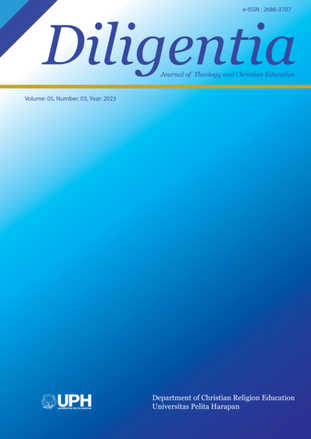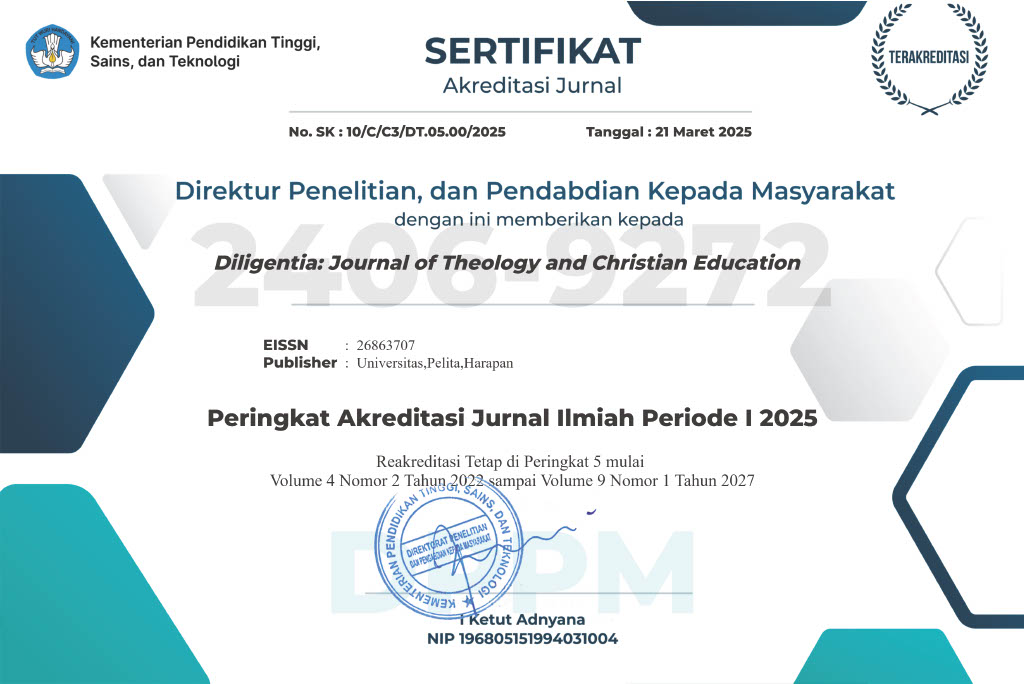Teologi Perjamuan Kudus menurut Kaum Anabaptis, Zwingli, dan Calvin: dalam Sejarah Reformasi [Theology of Holy Communion According to the Anabaptists, Zwingli, and Calvin: In the History of the Reformation]
DOI:
https://doi.org/10.19166/dil.v5i3.6850Keywords:
Perjamuan kudus, reformasi, John Calvin, Ulrich Zwingli, Anabaptists, holy communion, Lord's supper, reformation, Calvin, Zwingli, AnabaptisAbstract
The 5th century was a bleak time for the development of the church. The Bishop of Rome showed his supremacy over all churches and teachings, which led to the Reformation and the concept of Holy Communion. Holy Communion or Eucharist is interpreted as a form of Jesus' sacrifice accepted by His people through the fellowship of food and drink, namely the body (bread) and blood (wine). This raises the question of whether there is the presence of Christ Jesus in the food and drink or is it just a symbol. This research is to look at the views of reformer theologians Ulrich Zwingli, John Calvin and the Anabaptists on Holy Communion. The results of this study show that there are differences in understanding of Holy Communion. The Anabaptists understood the Supper in almost the same context as Zwingli, namely as a memorial without the presence of Christ. While John Calvin thought that Christ was present in the revelation of His Spirit to awaken His people to the work of salvation. The thing that makes their views on Eucharist theology the same is the excavation carried out based on the Word of God. The renewed understanding of Holy Communion is inseparable from the teaching of the Roman Catholic Church at that time which seemed to show its superiority where the Eucharist was considered the way for humans to get forgiveness of sins. The focus of Holy Communion can be understood as God's action to reveal the concept of Jesus' sacrifice as the powerful Christ, ruling through His Spirit and working in His members. And the specific meaning for His people today is to remember, repent, and have faith in Jesus as Lord and Savior.
BAHASA INDONESIA ABSTRACT: Abad ke 5 merupakan masa suram bagi perkembangan gereja. Uskup Roma menunjukkan supremasinya atas seluruh gereja dan pengajaran sehingga menggerakkan Reformasi dan salah satunya terhadap konsep Perjamuan Kudus. Perjamuan Kudus atau Ekaristi dimaknai sebagai bentuk pengorbanan Yesus yang diterima oleh umatNya melalui persekutuan makanan dan minuman yaitu tubuh (roti) dan darah (anggur). Hal ini menimbulkan pertanyaan apakah terdapat kehadiran Kristus Yesus dalam makanan dan minuman atau hanya merupakan simbol saja. Penelitian ini untuk melihat pandangan dari para teolog reformator Ulrich Zwingli, John Calvin dan Kaum Anabaptis terhadap Perjamuan Kudus. Hasil penelitian ini menunjukkan adanya perbedaan pemahaman tentang Perjamuan Kudus. Bagi kaum Anabaptis memahami Perjamuan dalam konteks yang hampir sama dengan Zwingli yakni sebagai peringatan tanpa kehadiran Kristus. Sementara John Calvin beranggapan bahwa Kristus ada dalam penyataan RohNya untuk menyadarkan umatNya tentang karya keselamatan. Hal yang menjadikan pandangan mereka pada Ekaristi teologi sama adalah penggalian yang dilakukan berdasarkan Firman Allah. Pembaharuan pemahaman terhadap Perjamuan Kudus tidak terlepas dari pengajaran Gereja Katolik Roma pada masa itu yang nampaknya menunjukkan superioritasnya dimana Ekaristi dianggap sebagai jalan manusia mendapatkan pengampunan dosa. Fokus dari Perjamuan Kudus dapat dipahami sebagai tindakan Tuhan untuk menyatakan konsep pengorbanan Yesus sebagai Kristus yang berkuasa, memerintah melalui Roh-Nya dan bekerja dalam anggota-anggotaNya. Dan makna khusus bagi umatNya saat ini adalah mengingat, bertobat, dan memiliki iman kepada Yesus sebagai Tuhan dan Juruselamat.
References
Aritonang, Jan Sihar. Garis besar sejarah Reformasi. Bandung, Indonesia: Jurnal Info Media, 2007.
Bentley, Wessel. "The Reconciliatory Role of Holy Communion in the Methodist Tradition." Verbum et Ecclesia 32, no. 2 (2011): 6. https://doi.org/10.4102/ve.v32i2.501.
Bernadette, P. "Tinjauan Terhadap Fenomena Substitusi Roti Dan Anggur Dalam Perjamuan Kudus Daring Menurut Pandangan Calvinis Dan Zwinglian." Consilium: Jurnal Teologi dan Pelayanan (2021): 1-5. http://repository.seabs.ac.id/handle/123456789/1399.
Botica, Dan A. "The Eucharist in the Theology of Martin Luther and John Calvin." Perichoresis 8, no. 2 (2010): 279-302. https://citeseerx.ist.psu.edu/document?repid=rep1&type=pdf&doi=d67779f2ebd46d76506a1968d1db5963d6b6c6a7.
Bulman, F. Raymod and Frederick J. Pamella. From Trent to Vatican II: Historical and Theological Investigation. New York, NY: Oxford University Press, 2006.
Goertz, Hans-Jurgen. The Anabaptists. Edited by McLeod Hugh and Scribner Bob. Oxfordshire, England: Routledge, 2013.
Hedges-Goettl, Barbara J. The Body Is Missing: Eucharistic Theology of the Presbyterian Church (USA) in Conversation with Zwingli, Calvin, and Nevin. Evanston, IL: Garrett-Evangelical Theological Seminary, 2013.
Jamieson, Bobby. Understanding the Lord's Supper. Nashville, TN: B&H Publishing Group, 2016.
Kirilov, Viacheslav. "Anabaptist Teaching on Community and its Influence on the Ecclesiology of the Russian ECB Brotherhood." Theological Reflections: Eastern European Journal of Theology, no. 18 (2017): 59-81. https://doi.org/10.29357/issn.2521-179X.2017.18.59.
Kristanto, Billy. "Reformasi Calvin dan Perjamuan Kudus." Verbum Christi: Jurnal Teologi Reformed Injili 4, no. 2 (2018): 171-91. https://doi.org/10.51688/vc4.2.2017.art1.
Lunardi, Jeconiah, and Billy Kristanto. "Ekaristi, Epiclesis, Dan Anamnesis Menurut Michael Welker Dan Alexander Schmemann Sebagai Diskusi Oikumenis Reformed Dengan Ortodoks Timur." Verbum Christi: Jurnal Teologi Reformed Injili 9, no. 1 (2022): 67-85. https://doi.org/10.51688/VC9.1.2022.art4.
Masrukhin, H. Metode Penelitian Kualitatif. Sidoarjo, Indonesia: Media Ilmu Press, 2014.
McGrath, Alister E. Sejarah Pemikiran Reformasi. Jakarta, Indonesia: BPK Gunung Mulia, 2019.
McMahon, Christopher. "Soteriology, Eucharist, and the Madness of Forgiveness." Journal of Moral Theology 5, no. 2 (2016): 44-65. https://jmt.scholasticahq.com/article/11315.pdf.
Pellerin, James, and Michael B. Edmond. "Infections Associated with Religious Rituals." International Journal of Infectious Diseases 17, no. 11 (2013): 945-48. https://doi.org/10.1016/j.ijid.2013.05.001.
Phelps, Jamie T. "Communion Ecclesiology and Black Liberation Theology." Theological Studies 61, no. 4 (2000): 672-99. https://doi.org/10.1177/004056390006100404.
Redekop, Benjamin W., and Calvin Redekop, eds. Power, Authority, and the Anabaptist Tradition. Baltimore, MD: JHU Press, 2001. https://doi.org/10.56021/9780801866050.
Sanchez, Michelle C. "Calvin and the Two Bodies of Christ: Fiction and Power in Dogmatic Theology." Political Theology 19, no. 5 (2018): 439-56. https://doi.org/10.1080/1462317X.2018.1440157.
Sugiyono, Sugiyono. Metode Penelitian Kuantitatif, Kualitatif, dan R&D. Bandung, Indonesia: CV. Alfabeta, 2008.
Sumiyati, Sumiyati, and Eriyani Mendrofa. "Implikasi Pedagogis Pada Sakramen Perjamuan Kudus Dalam Liturgi Gereja." Evangelikal: Jurnal Teologi Injili dan Pembinaan Warga Jemaat 5, no. 1 (2021): 116-26. https://doi.org/10.46445/ejti.v5i1.314.
White, James F. Pengantar Ibadah Kristen. Jakarta, Indonesia: BPK Gunung Mulia, 2011.
Downloads
Published
How to Cite
Issue
Section
License
Authors who publish with this journal agree to the following terms:
1) Authors retain copyright and grant the journal right of first publication with the work simultaneously licensed under a Creative Commons Attribution License (CC-BY-SA 4.0) that allows others to share the work with an acknowledgement of the work's authorship and initial publication in this journal.
2) Authors are able to enter into separate, additional contractual arrangements for the non-exclusive distribution of the journal's published version of the work (e.g., post it to an institutional repository or publish it in a book), with an acknowledgement of its initial publication in this journal.
3) Authors are permitted and encouraged to post their work online (e.g., in institutional repositories or on their website). The final published PDF should be used and bibliographic details that credit the publication in this journal should be included














